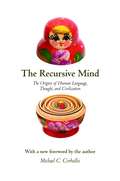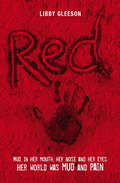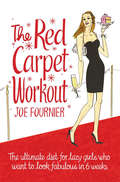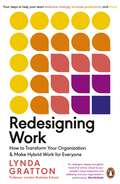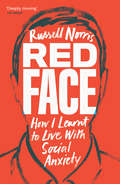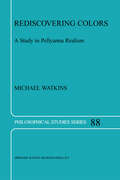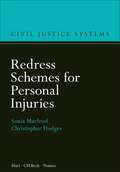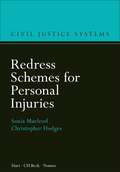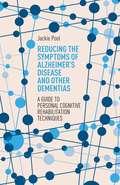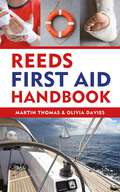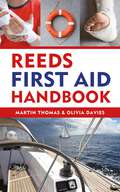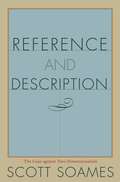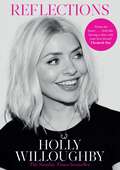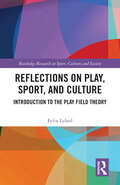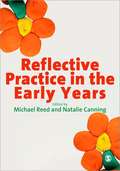- Table View
- List View
The Recursive Mind: The Origins of Human Language, Thought, and Civilization
by Michael C. CorballisThe Recursive Mind challenges the commonly held notion that language is what makes us uniquely human. In this compelling book, Michael Corballis argues that what distinguishes us in the animal kingdom is our capacity for recursion: the ability to embed our thoughts within other thoughts. "I think, therefore I am," is an example of recursive thought, because the thinker has inserted himself into his thought. Recursion enables us to conceive of our own minds and the minds of others. It also gives us the power of mental "time travel"--the ability to insert past experiences, or imagined future ones, into present consciousness. Drawing on neuroscience, psychology, animal behavior, anthropology, and archaeology, Corballis demonstrates how these recursive structures led to the emergence of language and speech, which ultimately enabled us to share our thoughts, plan with others, and reshape our environment to better reflect our creative imaginations. He shows how the recursive mind was critical to survival in the harsh conditions of the Pleistocene epoch, and how it evolved to foster social cohesion. He traces how language itself adapted to recursive thinking, first through manual gestures, then later, with the emergence of Homo sapiens, vocally. Toolmaking and manufacture arose, and the application of recursive principles to these activities in turn led to the complexities of human civilization, the extinction of fellow large-brained hominins like the Neandertals, and our species' supremacy over the physical world.
Red (Little Hare Classics Ser.)
by Libby GleesonA young girl wakes, smothered in mud, suffering from amnesia after a cyclone hits Sydney. She remembers nothing of her past. She is rescued by Peri, a young boy not much older than her who names her Red. Peri appears to be streetwise and encourages her escape from the damaged city. And then, Red discovers her real name. And that she has a father. A memory stick on a chain around her neck contains vital information which needs to be conveyed to the nation's capital. In Red's head are mysterious words - a name? A clue to her past? To the whereabouts of her missing dad? To her future ...With new friends to help her, Red makes an exciting, dangerous cross-country journey - but time is running out ...
Red and White blood cells (Uncontracted UEB)
by RnibDiagram showing front and side views of a red blood cell, and the two types of white blood cell (lymphocyte and phagocyte).
Red Carpet Workout
by Jordan Paramor Joe FournierDo you want to shift the bulge and still indulge?Do you want to lose weight, but still have a life?Do you have a big event looming that you need to shape up for - fast?All big stars train for their red carpet moments, now in just 6 weeks, you can train for yours. And still have fun.The Red Carpet Workout, fronted by celebrity and sporting trainer, Joe Fournier, is not just a quick-fix diet, it’s a way of life. The book brings together all the experience, tough love and motivational tips Joe uses to get A-listers into top shape – he will show you how to get fab results, quickly! Losing weight doesn’t have to be all about eating mung beans, and doing stomach crunches - we all know that in the real world no one carries a tupperware box full of carrot sticks. This book will be no-nonsense, fun guide to shaping up and still treating yourself and includes: insider Secrets from A-listers; exercises that tackle specific body parts like “A-List abs” “Oscar arms” and “Bafta bum” and a ‘champagne shape-up’ that allows you to drink and still shift poundsYou can get the hot body you have always wanted – but just been too lazy to make happen.
Redefining Aging: A Caregiver's Guide to Living Your Best Life
by Ann Kaiser StearnsCaring for an elderly family member can be overwhelming. But fulfilling life experiences are still possible for both caregivers and their loved ones, despite the stress and fatigue of caregiving.In this comprehensive book, best-selling author Ann Kaiser Stearns explores the practical and personal challenges of both caregiving and successful aging. She couples findings from the latest research with powerful insights and problem-solving tips to help caregivers achieve the best life possible for those they care for;¢;‚¬;€?and for themselves as they age. Topics include;€¢ Improving the quality of life for the one giving and the one receiving care;€¢ Distinguishing normal aging from early warning signs ;€¢ Understanding caregiver sadness, resentment, guilt, and grief;€¢ Using strategies and skills to minimize an impaired elder's distress and emotional outbursts and the caregiver's own anxieties about growing old;€¢ Finding resources to aid in the care of the loved one and protect the caregiver from stress overload ;€¢ Moving forward after the death of a loved one to have a meaningful life of one's own ;€¢ Overcoming ageist stereotypes and deciding what kind of "old person" one will be;€¢ Making life easier for those who someday will care for usRedefining Aging will help readers think differently about caregiving and their own aging.
Redefining Aging: A Caregiver's Guide to Living Your Best Life
by Ann Kaiser StearnsCaring for an elderly family member can be overwhelming. But fulfilling life experiences are still possible for both caregivers and their loved ones, despite the stress and fatigue of caregiving.In this comprehensive book, best-selling author Ann Kaiser Stearns explores the practical and personal challenges of both caregiving and successful aging. She couples findings from the latest research with powerful insights and problem-solving tips to help caregivers achieve the best life possible for those they care for;¢;‚¬;€?and for themselves as they age. Topics include;€¢ Improving the quality of life for the one giving and the one receiving care;€¢ Distinguishing normal aging from early warning signs ;€¢ Understanding caregiver sadness, resentment, guilt, and grief;€¢ Using strategies and skills to minimize an impaired elder's distress and emotional outbursts and the caregiver's own anxieties about growing old;€¢ Finding resources to aid in the care of the loved one and protect the caregiver from stress overload ;€¢ Moving forward after the death of a loved one to have a meaningful life of one's own ;€¢ Overcoming ageist stereotypes and deciding what kind of "old person" one will be;€¢ Making life easier for those who someday will care for usRedefining Aging will help readers think differently about caregiving and their own aging.
Redemption Bar: Alcohol-free cocktails with benefits
by Catherine Salway Andrea WatersSpoil yourself without spoiling yourself! Alcohol-free drinks have never been more glamorous thanks to this stunning new book by Andrea Waters and Catherine Salway, founders of the hugely popular Redemption Bar. Learn how to make delicious, alcohol-free cocktails and tasty canapés that will dazzle your guests and delight your taste buds.Packed with nutritious recipes, Redemption Bar has something for everyone, with a variety of vegan, low sugar and gluten-free recipes available.Quirky, alcohol-free cocktail recipes include: Lychee and Yuzu Martinis, Pineapple Margaritas, and Strawberry & Mango Daiquiris. The book also offers a range of delicious canapés for light snacks and entertaining, from Slow-roasted Activated Almonds to Miso Glazed Baby Aubergine Skewers.
Redesigning Work: How to Transform Your Organisation and Make Hybrid Work for Everyone
by Lynda GrattonWe are experiencing the greatest global shift in the world of work for a century. So, how do we make the most of this unique opportunity and radically redesign the way we work - forever?Professor Lynda Gratton is the global thought-leader on the future of work. Based on thirty years of research into the technological, demographic, cultural and societal trends that are shaping work, and building on what we learnt through our experiences of the global pandemic, Lynda Gratton presents her innovative four step framework for redesigning work that will help you: Understand the challenges your business is facingReimagine creative, new approaches and processesModel and Test these within your organisationAct and Create based on contemporary, data-led feedbackWhether you're working in a small team or running a multinational, this is the time to make lasting change and equip your business for the future. Redesigning Work is the definitive book on how to transform your organisation and make hybrid working work for you. It will help your team embrace change, increase productivity and thrive in our new, more flexible working world.
Redface: How I Learnt to Live With Social Anxiety
by Russell Norris'Empowering and cathartic' – Dr Tracy Cooper, International Consultant on High Sensitivity 'Deeply moving and informative' – Lily Bailey, author As an adolescent, Russell’s face and neck would turn crimson at the slightest thing. In his twenties he began suffering from an extreme form of blushing (idiopathic craniofacial erythema). It sent out all the wrong signals — to friends, family and to the opposite sex. And it triggered something worse: Social Anxiety Disorder. Up to one in 10 people develop this irrational fear of other human beings. From university to the workplace, Russell desperately tried to hide his secret from everyone. In a forlorn attempt to be ‘normal,’ he grabbed every remedy going, from drugs to herbs to bottles of absinthe. By turns wry and shocking, dark and optimistic, Redface is the eye-opening true story of one man’s struggle with his mental health. And how he found his own way forward in a world built for others. It will fascinate readers who are socially anxious, their friends and family, and anyone who wants to know what it’s like to travel to the edge of human experience and back.
Rediscovering Colors: A Study in Pollyanna Realism (Philosophical Studies Series #88)
by M. WatkinsIn Rediscovering Colors: A Study in Pollyanna Realism, Michael Watkins endorses the Moorean view that colors are simple, non-reducible, properties of objects. Consequently, Watkins breaks from what has become the received view that either colors are reducible to certain properties of interest to science, or else nothing is really colored. What is novel about the work is that Watkins, unlike other Mooreans, takes seriously the metaphysics of colors. Consequently, Watkins provides an account of what colors are, how they are related to the physical properties on which they supervene, and how colors can be causally efficacious without the threat of causal overdetermination. Along the way, he provides novel accounts of normal conditions and non-human color properties. The book will be of interest to any metaphysician and philosopher of mind interested in colors and color perception.
Rediscovering the History of Psychology: Essays Inspired by the Work of Kurt Danziger (History and Philosophy of Psychology)
by Johann Louw Adrian Brock Willem Van HoornFor the last 25 years, Kurt Danziger's work has been at the center of developments in history and theory of psychology. This volume makes Danziger's work the focal point of a variety of contributions representing several active areas of research. Written by the leading figures in history and theory of psychology from North America, Europe and South Africa, including Danziger himself, it will serve as a point of departure for those who wish to acquaint themselves with some of the most important issues in this field.
Redress Schemes for Personal Injuries (Civil Justice Systems)
by Sonia Macleod Christopher HodgesThis ground-breaking book takes a fresh look at potential non-litigation solutions to providing personal injury compensation. It is the first systematic comparative study of such a large number – over forty – of personal injury compensation schemes. It covers the drivers for their creation, the frameworks under which they operate, the criteria and thresholds used, the compensation offered, the claims process, statistics on throughput and costs, and analysis of financial costings. It also considers and compares the successes and failings of these schemes. Many different types of redress providers are studied. These include the comprehensive no-blame coverage offered by the New Zealand Accident Compensation Corporation; the widely used Patient, Pharmaceutical, Motor Accident and Workers Compensation Insurance systems of the Nordic states; the far smaller issue-focused schemes like the UK Thalidomide and vCJD Trusts; vaccine damage schemes that exist in many countries; as well as motor vehicle schemes from the USA. Conclusions are drawn about the functions, essential requirements, architecture, scope, operation and performance of personal injury compensation systems. The relationships between such schemes, the courts and regulators are also discussed, and both calls and need for reforms are noted.Noting the wide calls for reform of NHS medical negligence litigation within the UK, and its replacement with a no blame approach, the authors' findings outline options for future policy in this area. This major contribution builds on general shifts from courts to ADR, and from blame to no blame in regulation, and is a work that has the potential to have a major impact on the field of personal injury redress.With contributions by Raymond Byrne, Claire Bright, Shuna Mason, Magdalena Tulibacka, Matti Urho, Mary Walker and Herbert Woopen.
Redress Schemes for Personal Injuries (Civil Justice Systems)
by Sonia Macleod Christopher HodgesThis ground-breaking book takes a fresh look at potential non-litigation solutions to providing personal injury compensation. It is the first systematic comparative study of such a large number – over forty – of personal injury compensation schemes. It covers the drivers for their creation, the frameworks under which they operate, the criteria and thresholds used, the compensation offered, the claims process, statistics on throughput and costs, and analysis of financial costings. It also considers and compares the successes and failings of these schemes. Many different types of redress providers are studied. These include the comprehensive no-blame coverage offered by the New Zealand Accident Compensation Corporation; the widely used Patient, Pharmaceutical, Motor Accident and Workers Compensation Insurance systems of the Nordic states; the far smaller issue-focused schemes like the UK Thalidomide and vCJD Trusts; vaccine damage schemes that exist in many countries; as well as motor vehicle schemes from the USA. Conclusions are drawn about the functions, essential requirements, architecture, scope, operation and performance of personal injury compensation systems. The relationships between such schemes, the courts and regulators are also discussed, and both calls and need for reforms are noted.Noting the wide calls for reform of NHS medical negligence litigation within the UK, and its replacement with a no blame approach, the authors' findings outline options for future policy in this area. This major contribution builds on general shifts from courts to ADR, and from blame to no blame in regulation, and is a work that has the potential to have a major impact on the field of personal injury redress.With contributions by Raymond Byrne, Claire Bright, Shuna Mason, Magdalena Tulibacka, Matti Urho, Mary Walker and Herbert Woopen.
Reducing Risk in Fertility Treatment
by Raj MathurIn the last 15 years, fertility treatment has become mainstream medical practice. With this evolution has come a change in focus from effectiveness (‘success rates’) to safety, patient acceptability and ethical questions. It is recognized that effectiveness also depends crucially on safety and good risk management. The purpose of this book is to address this wider change in focus. Reducing Risk in Fertility Treatment examines risk in assisted conception, covering a wide range of topics and areas. ‘Risk’ refers to situations in which an outcome of value to people is uncertain. Specifically for the purpose of this book, ‘Risk’ means situations where patients or professionals or society as a whole is at risk of an adverse outcome in relation to fertility treatment. It therefore encompasses clinical complications, risks inherent in laboratory practice, reputational and business risks to clinics and ethical risks to society as a whole. It will be an essential resource for all clinic staff to consult in reducing the risk associated with their work. It will provide practical resources such as ‘how to’ guides, but also a theoretical discussion of uncertainty where this exists. The book is primarily directed to practitioners in the area of fertility treatment, namely clinicians, embryologists, nurses, counsellors and administrators. However, it is likely also to be relevant to policy-makers, commissioners of health services, researchers in this field and biomedical ethicists.
Reducing the Symptoms of Alzheimer’s Disease and Other Dementias: A Guide to Personal Cognitive Rehabilitation Techniques
by Jackie PoolThis innovative new book sets out practical guidance for people with dementia, their families and carers on reducing the symptoms of Alzheimer's disease and other dementias. Applying a 'rementia' based approach to dementia care, Jackie Pool shows how therapeutic cognitive rehabilitation techniques can be used to reduce symptoms of dementia and ultimately improve quality of life for people living with dementia.Covering topics such as nutrition, stress, communication, memory and sleep, it provides all the tools and information necessary to build a personalised and flexible self-care plan which will improve and sustain quality of life. By clearing away the myths and stigma surrounding dementia, this book creates room for cooperation, creativity and hope.
Reducing the Symptoms of Alzheimer’s Disease and Other Dementias: A Guide to Personal Cognitive Rehabilitation Techniques
by Jackie PoolThis innovative new book sets out practical guidance for people with dementia, their families and carers on reducing the symptoms of Alzheimer's disease and other dementias. Applying a 'rementia' based approach to dementia care, Jackie Pool shows how therapeutic cognitive rehabilitation techniques can be used to reduce symptoms of dementia and ultimately improve quality of life for people living with dementia.Covering topics such as nutrition, stress, communication, memory and sleep, it provides all the tools and information necessary to build a personalised and flexible self-care plan which will improve and sustain quality of life. By clearing away the myths and stigma surrounding dementia, this book creates room for cooperation, creativity and hope.
Reeds First Aid Handbook
by Martin Thomas Dr Olivia DaviesWhether you are sailing, motorboating, pottering around in a dinghy, racing, going fishing offshore or embarking on an ocean crossing, this is the essential pocket-sized guide to first aid you need to have on board.Aimed specifically at boaters, it covers every medical problem you may encounter on board, from common issues such as seasickness and sunburn to more serious problems such as broken bones and emergencies including heart attacks and strokes. Every problem is graded for its seriousness, indicating whether it is something you can treat yourself that needn't mean the end of the trip, or whether you should head back to shore or summon help immediately. It guides you in how to make someone comfortable and, in the most serious circumstances, improve their chances of making a full recovery.Clear, full-colour step by step diagrams illustrate succinct instructions for quick reference. The book also includes a guide on what to include in your on-board first aid kit, which differs depending on where you are going, and how long and how far you will be away from the nearest assistance.A handy reference to have on board wherever you are going, this book will boost your confidence, help you solve medical problems, and minimise the dangers in emergencies.
Reeds First Aid Handbook
by Martin Thomas Dr Olivia DaviesWhether you are sailing, motorboating, pottering around in a dinghy, racing, going fishing offshore or embarking on an ocean crossing, this is the essential pocket-sized guide to first aid you need to have on board.Aimed specifically at boaters, it covers every medical problem you may encounter on board, from common issues such as seasickness and sunburn to more serious problems such as broken bones and emergencies including heart attacks and strokes. Every problem is graded for its seriousness, indicating whether it is something you can treat yourself that needn't mean the end of the trip, or whether you should head back to shore or summon help immediately. It guides you in how to make someone comfortable and, in the most serious circumstances, improve their chances of making a full recovery.Clear, full-colour step by step diagrams illustrate succinct instructions for quick reference. The book also includes a guide on what to include in your on-board first aid kit, which differs depending on where you are going, and how long and how far you will be away from the nearest assistance.A handy reference to have on board wherever you are going, this book will boost your confidence, help you solve medical problems, and minimise the dangers in emergencies.
Reference and Description: The Case against Two-Dimensionalism
by Scott SoamesIn this book, Scott Soames defends the revolution in philosophy led by Saul Kripke, Hilary Putnam, and David Kaplan against attack from those wishing to revive descriptivism in the philosophy of language, internalism in the philosophy of mind, and conceptualism in the foundations of modality. Soames explains how, in the last twenty-five years, this attack on the anti-descriptivist revolution has coalesced around a technical development called two-dimensional modal logic that seeks to reinterpret the Kripkean categories of the necessary aposteriori and the contingent apriori in ways that drain them of their far-reaching philosophical significance. Arguing against this reinterpretation, Soames shows how the descriptivist revival has been aided by puzzles and problems ushered in by the anti-descriptivist revolution, as well as by certain errors and missteps in the anti-descriptivist classics themselves. Reference and Description sorts through all this, assesses and consolidates the genuine legacy of Kripke and Kaplan, and launches a thorough and devastating critique of the two-dimensionalist revival of descriptivism. Through it all, Soames attempts to provide the outlines of a lasting, nondescriptivist perspective on meaning, and a nonconceptualist understanding of modality.
Reference and Description: The Case against Two-Dimensionalism
by Scott SoamesIn this book, Scott Soames defends the revolution in philosophy led by Saul Kripke, Hilary Putnam, and David Kaplan against attack from those wishing to revive descriptivism in the philosophy of language, internalism in the philosophy of mind, and conceptualism in the foundations of modality. Soames explains how, in the last twenty-five years, this attack on the anti-descriptivist revolution has coalesced around a technical development called two-dimensional modal logic that seeks to reinterpret the Kripkean categories of the necessary aposteriori and the contingent apriori in ways that drain them of their far-reaching philosophical significance. Arguing against this reinterpretation, Soames shows how the descriptivist revival has been aided by puzzles and problems ushered in by the anti-descriptivist revolution, as well as by certain errors and missteps in the anti-descriptivist classics themselves. Reference and Description sorts through all this, assesses and consolidates the genuine legacy of Kripke and Kaplan, and launches a thorough and devastating critique of the two-dimensionalist revival of descriptivism. Through it all, Soames attempts to provide the outlines of a lasting, nondescriptivist perspective on meaning, and a nonconceptualist understanding of modality.
Reference, Truth and Conceptual Schemes: A Defense of Internal Realism (Synthese Library #296)
by G. Forrai1. HISTORICAL BACKGROUND The purpose of the book is to develop internal realism, the metaphysical-episte mological doctrine initiated by Hilary Putnam (Reason, Truth and History, "Introduction", Many Faces). In doing so I shall rely - sometimes quite heavily - on the notion of conceptual scheme. I shall use the notion in a somewhat idiosyncratic way, which, however, has some affinities with the ways the notion has been used during its history. So I shall start by sketching the history of the notion. This will provide some background, and it will also give opportunity to raise some of the most important problems I will have to solve in the later chapters. The story starts with Kant. Kant thought that the world as we know it, the world of tables, chairs and hippopotami, is constituted in part by the human mind. His cen tral argument relied on an analysis of space and time, and presupposed his famous doctrine that knowledge cannot extend beyond all possible experience. It is a central property of experience - he claimed - that it is structured spatially and temporally. However, for various reasons, space and time cannot be features of the world, as it is independently of our experience. So he concluded that they must be the forms of human sensibility, i. e. necessary ingredients of the way things appear to our senses.
Reflections: The Sunday Times bestselling book of life lessons from superstar presenter Holly Willoughby
by Holly WilloughbyTHE SUNDAY TIMES BESTSELLER'From the heart. It feels so authentic . . . Encompassing and inclusive . . . Reads beautifully and fluidly and feels like having a chat with your best friend' - Elizabeth Day on HOW TO FAIL'The book is a triumph...an accessible insight into the woman behind the brand' Grazia________________________Have you ever found yourself in that moment where you just wonder - what's next? I could carry on as I am but there's a yearning for something else. That's where this book started for me...Presenter. Fashion icon. Wife. Mother. Holly Willoughby lights up the nation's TV screens every day but, like all of us, she has struggled with moments of self-doubt, feelings of guilt, anger and detachment. Here she shares how she has learned to reconnect with herself in order to face her fears head on. With her trademark warmth, Holly shows how listening to her inner voice and celebrating life's little moments of beauty and joy - like looking up at the moon or finding the perfect red lipstick - helped her feel whole again. Reflections is an empathetic, encouraging book that will inspire you to live your most beautiful, authentic life.WHAT READERS ARE SAYING:-'I rarely read and read this book in two days! Much of what Holly wrote about resonated with me and I've taken so much practical advice away with me.'-'Like little snippets of therapy'-'This book is brilliant. Holly addresses many things that we all face in life and gives her best advice on how to overcome them. Fantastic for anyone but mostly anyone who suffers any kind of anxieties or self consciousness. -'Amazing . . . Holly is just fabulous and I can't put it down, so nice to know we aren't in this journey alone' -'So beautifully written and relatable in lots of ways. It will be a book that I am sure I will keep taking off of my book shelf to keep going back to read for a long time'
Reflections on Play, Sport, and Culture: Introduction to the Play Field Theory (Routledge Research in Sport, Culture and Society #141)
by Felix LebedThe psychological dependence of humanity on playing is huge. Its nature and functional utility are unclear. These linked yet contradictory issues have created the intrigue that has fed philosophical thought for more than two hundred years. During this period, philosophy transferred many of the subjects of its analysis to the aegis of the humanities that it spawned. Each of them pays close attention to human play and studies it with its own methods of theoretical and experimental research. Thus, what was once a general philosophical comprehension of human play has branched out into different directions, definitions, and theories. This new book represents a renewed general view of human play. The unique quality of the volume lies in its fairly rare interdisciplinary methodology, encompassing a broad spectrum of the humanities: philosophy, anthropology, sociology, and the history of play, and behavioral analysis of playing, which have been done by the author. As a result, the volume ends with the proposition of a new general approach to human play that is named by the author “play field theory”. Such an approach makes reflections on play, sport, and culture a source for all scholars studying play, by widening their knowledge through both a new general view and their familiarization with notions from neighboring fields and disciplines.
Reflections on Play, Sport, and Culture: Introduction to the Play Field Theory (Routledge Research in Sport, Culture and Society #141)
by Felix LebedThe psychological dependence of humanity on playing is huge. Its nature and functional utility are unclear. These linked yet contradictory issues have created the intrigue that has fed philosophical thought for more than two hundred years. During this period, philosophy transferred many of the subjects of its analysis to the aegis of the humanities that it spawned. Each of them pays close attention to human play and studies it with its own methods of theoretical and experimental research. Thus, what was once a general philosophical comprehension of human play has branched out into different directions, definitions, and theories. This new book represents a renewed general view of human play. The unique quality of the volume lies in its fairly rare interdisciplinary methodology, encompassing a broad spectrum of the humanities: philosophy, anthropology, sociology, and the history of play, and behavioral analysis of playing, which have been done by the author. As a result, the volume ends with the proposition of a new general approach to human play that is named by the author “play field theory”. Such an approach makes reflections on play, sport, and culture a source for all scholars studying play, by widening their knowledge through both a new general view and their familiarization with notions from neighboring fields and disciplines.
Reflective Practice In The Early Years (PDF)
by Michael ReedWritten for anyone working in the field of early years education and care, this book encourages students and practitioners to consider their own practice and to examine practice in a wide range of early years settings.
